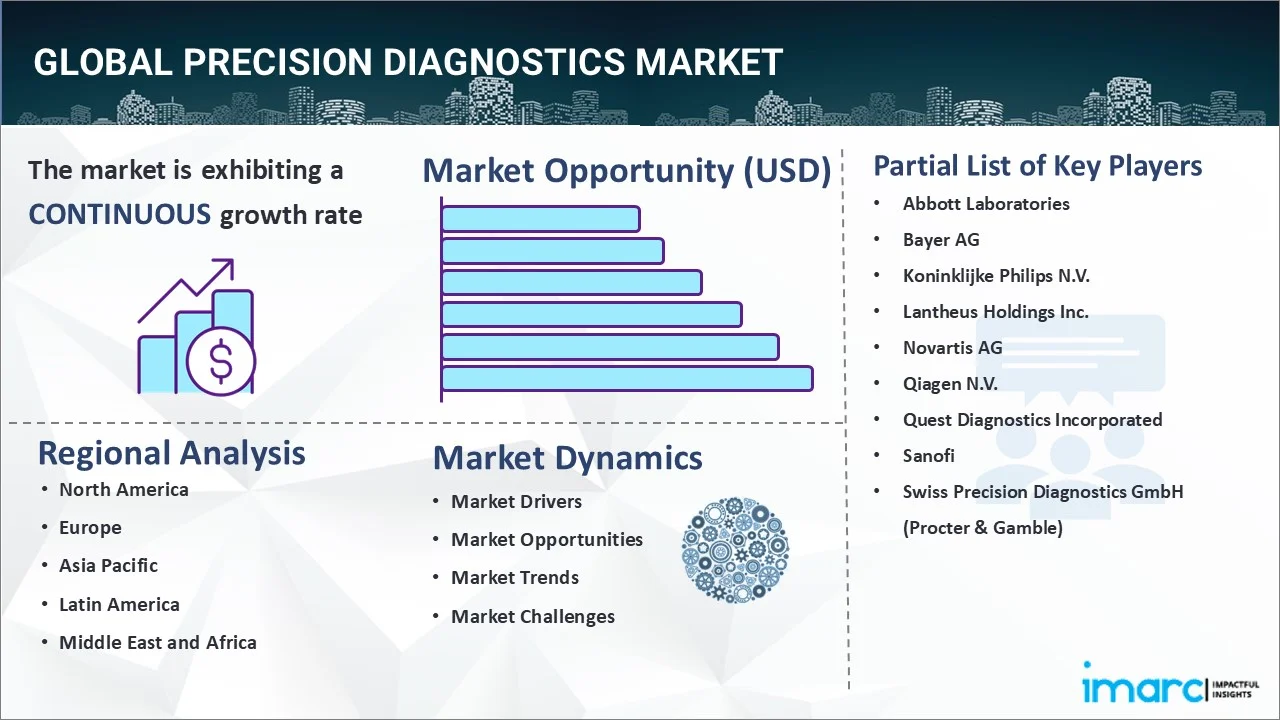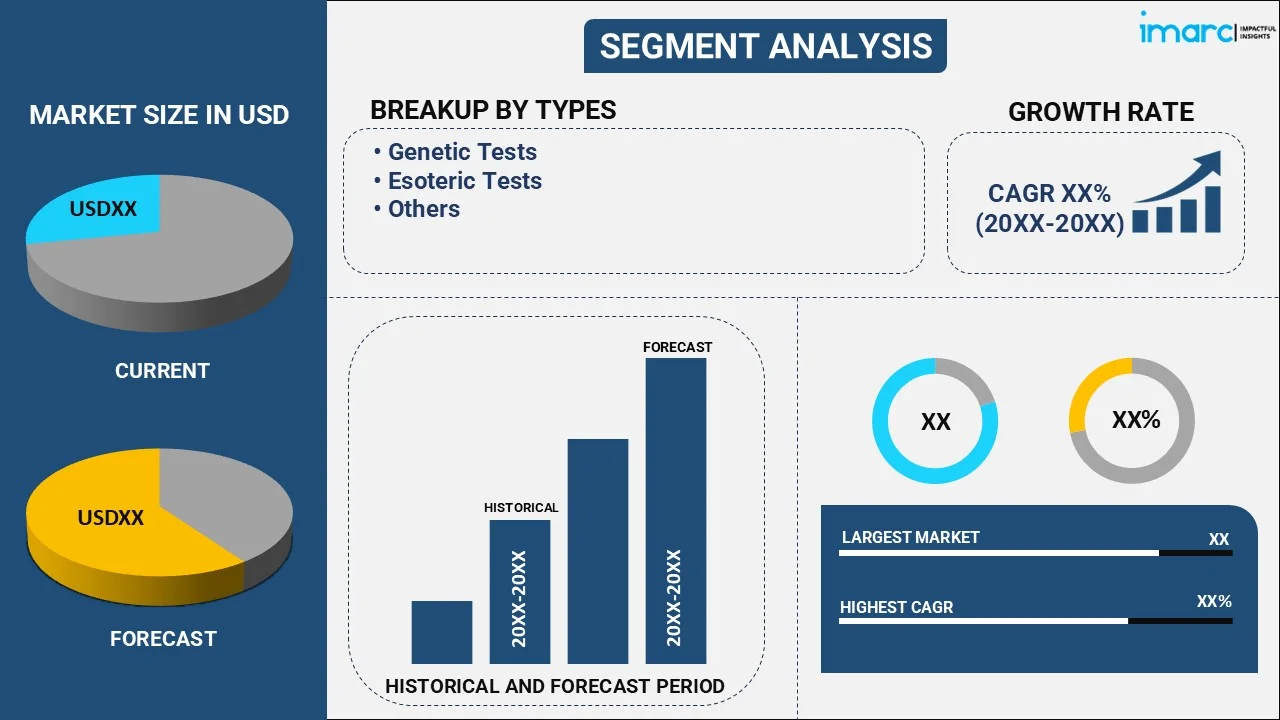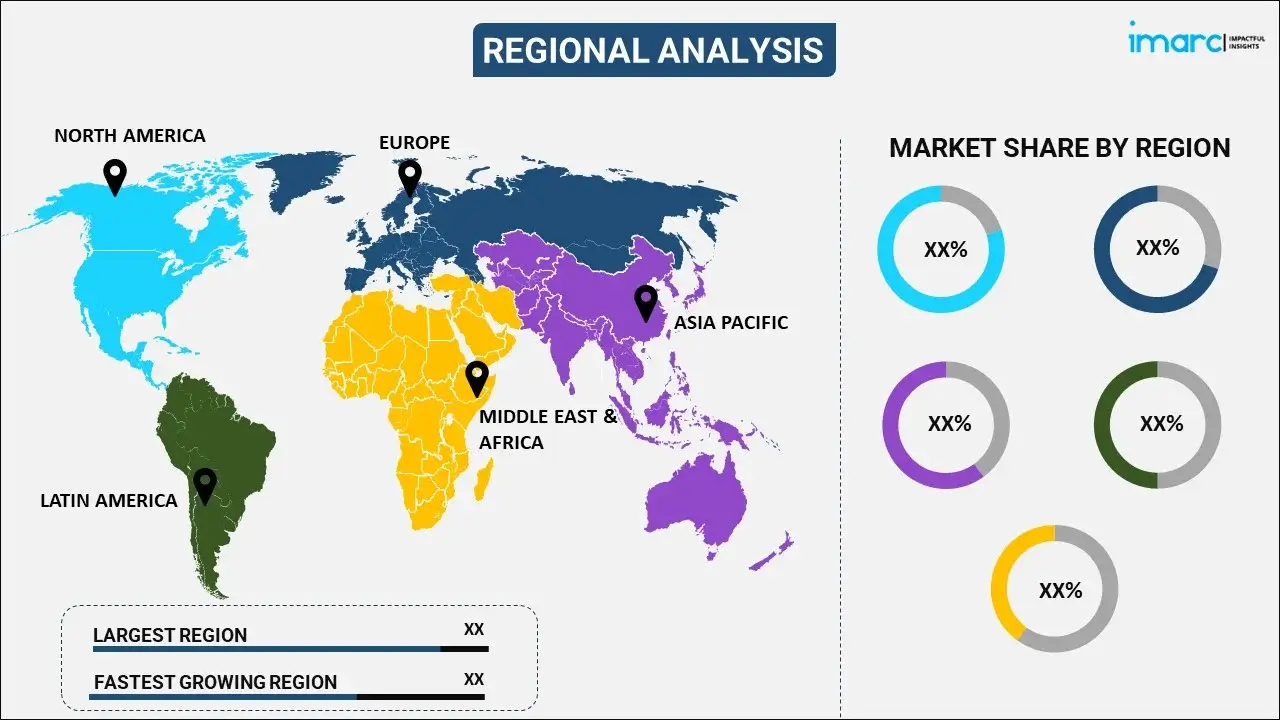
Precision Diagnostics Market Report by Type (Genetic Tests, Esoteric Tests, and Others), Application (Oncology, Cardiology, Immunology, and Others), End User (Hospitals, Clinical Laboratories, Homecare), and Region 2025-2033
Market Overview:
The global precision diagnostics market size reached USD 83.4 Billion in 2024. Looking forward, IMARC Group expects the market to reach USD 207.0 Billion by 2033, exhibiting a growth rate (CAGR) of 10.09% during 2025-2033. The increasing demand for personalized medicine, advancements in genomics and molecular diagnostics, and growing awareness regarding diagnostic procedures represent some of the key factors driving the market.
|
Report Attribute
|
Key Statistics
|
|---|---|
|
Base Year
|
2024 |
|
Forecast Years
|
2025-2033
|
|
Historical Years
|
2019-2024
|
| Market Size in 2024 | USD 83.4 Billion |
| Market Forecast in 2033 | USD 207.0 Billion |
| Market Growth Rate 2025-2033 | 10.09% |
Precision diagnostics, also known as precision medicine diagnostics or personalized diagnostics, refers to a branch of medicine that uses advanced diagnostic techniques and technologies to tailor medical decisions, treatments, and interventions to individual patients. It involves the use of various diagnostic tests, including genetic testing, molecular profiling, imaging, and other advanced diagnostic modalities, to gather detailed information about a patient's unique genetic makeup, molecular characteristics, and disease status. It provides precise and targeted information that helps healthcare providers understand a patient's disease or condition, predict their response to specific treatments, and develop personalized treatment plans. It can also provide information about the prognosis of a disease, helping to identify patients who are at higher risk or may require more aggressive treatments. Moreover, it enables healthcare professionals to make more informed decisions about disease prevention, diagnosis, treatment selection, and monitoring. In addition, these procedures improve patient outcomes, enhance treatment efficacy, minimize adverse effects, and optimize healthcare resource utilization.

Precision Diagnostics Market Trends:
The market is primarily driven by the demand for personalized medicine. Precision diagnostics play a crucial role in the field of personalized medicine by providing precise information about a patient's genetic makeup, disease susceptibility, and treatment response. In addition, various technological advancements in genomics and molecular diagnostics represent another major growth-inducing factor. The emergence of technologies such as next-generation sequencing (NGS), gene expression profiling, and molecular imaging techniques have enhanced the understanding of diseases at a molecular level, enabling the development of more accurate and targeted diagnostic tests. Besides this, the rising prevalence of chronic diseases, such as cancer, cardiovascular diseases, and diabetes, is accelerating the adoption of precise diagnostics to aid in early detection, accurate diagnosis, and monitoring of these diseases. This, coupled with the growing awareness regarding early detection of disease and companion diagnostics, is contributing to market growth. Moreover, the market is further propelled by the introduction of microfluidics, lab-on-a-chip technologies, and point-of-care testing devices, which have made diagnostics more accessible, portable, and cost-effective, allowing for faster and real-time results, especially in resource-limited settings and remote areas. Furthermore, the rising healthcare expenditure and the developing healthcare infrastructure worldwide are also creating a favorable market outlook across the globe.
Key Market Segmentation:
IMARC Group provides an analysis of the key trends in each segment of the global precision diagnostics market, along with forecasts at the global, regional, and country levels for 2025-2033. Our report has categorized the market based on type, application, and end user.
Type Insights:

- Genetic Tests
- Esoteric Tests
- Others
The report has provided a detailed breakup and analysis of the precision diagnostics market based on the type. This includes genetic tests, esoteric tests, and others. According to the report, genetic tests represented the largest segment.
Application Insights:
- Oncology
- Cardiology
- Immunology
- Others
A detailed breakup and analysis of the precision diagnostics market based on the application has also been provided in the report. This includes oncology, cardiology, immunology, and others. According to the report, oncology accounted for the largest market share.
End User Insights:
- Hospitals
- Clinical Laboratories
- Homecare
The report has provided a detailed breakup and analysis of the precision diagnostics market based on the end user. This includes hospitals, clinical laboratories, and homecare. According to the report, clinical laboratories represented the largest segment.
Regional Insights:

- North America
- United States
- Canada
- Europe
- Germany
- France
- United Kingdom
- Italy
- Spain
- Others
- Asia Pacific
- China
- Japan
- India
- South Korea
- Australia
- Indonesia
- Others
- Latin America
- Brazil
- Mexico
- Others
- Middle East and Africa
The report has also provided a comprehensive analysis of all the major regional markets, which include North America (the United States and Canada); Europe (Germany, France, the United Kingdom, Italy, Spain, and others); Asia Pacific (China, Japan, India, South Korea, Australia, Indonesia, and others); Latin America (Brazil, Mexico, and others); and the Middle East and Africa. According to the report, North America was the largest market for precision diagnostics. Some of the factors driving the North America precision diagnostics market included the growing prevalence of chronic diseases, the escalating demand for personalized medicine, and the rising awareness among masses regarding early diagnosis of diseases.
Competitive Landscape:
The report has also provided a comprehensive analysis of the competitive landscape in the global precision diagnostics market. Competitive analysis such as market structure, market share by key players, player positioning, top winning strategies, competitive dashboard, and company evaluation quadrant has been covered in the report. Also, detailed profiles of all major companies have been provided. Some of the companies covered include Abbott Laboratories, Bayer AG, Koninklijke Philips N.V., Lantheus Holdings Inc., Novartis AG, Qiagen N.V., Quest Diagnostics Incorporated, Sanofi, and Swiss Precision Diagnostics GmbH (Procter & Gamble),etc. Kindly note that this only represents a partial list of companies, and the complete list has been provided in the report.
Report Coverage:
| Report Features | Details |
|---|---|
| Base Year of the Analysis | 2024 |
| Historical Period | 2019-2024 |
| Forecast Period | 2025-2033 |
| Units | Billion USD |
| Scope of the Report | Exploration of Historical and Forecast Trends, Industry Catalysts and Challenges, Segment-Wise Historical and Predictive Market Assessment:
|
| Types Covered | Genetic Tests, Esoteric Tests, Others |
| Applications Covered | Oncology, Cardiology, Immunology, Others |
| End Users Covered | Hospitals, Clinical Laboratories, Homecare |
| Regions Covered | North America, Europe, Asia Pacific, Latin America, Middle East and Africa |
| Countries Covered | United States, Canada, Germany, France, United Kingdom, Italy, Spain, China, Japan, India, South Korea, Australia, Indonesia, Brazil, Mexico |
| Companies Covered | Abbott Laboratories, Bayer AG, Koninklijke Philips N.V., Lantheus Holdings Inc., Novartis AG, Qiagen N.V., Quest Diagnostics Incorporated, Sanofi, Swiss Precision Diagnostics GmbH (Procter & Gamble),etc. |
| Customization Scope | 10% Free Customization |
| Post-Sale Analyst Support | 10-12 Weeks |
| Delivery Format | PDF and Excel through Email (We can also provide the editable version of the report in PPT/Word format on special request) |
Key Questions Answered in This Report:
- How has the global precision diagnostics market performed so far, and how will it perform in the coming years?
- What are the drivers, restraints, and opportunities in the global precision diagnostics market?
- What is the impact of each driver, restraint, and opportunity on the global precision diagnostics market?
- What are the key regional markets?
- Which countries represent the most attractive precision diagnostics market?
- What is the breakup of the market based on the type?
- Which is the most attractive type in the precision diagnostics market?
- What is the breakup of the market based on the application?
- Which is the most attractive application in the precision diagnostics market?
- What is the breakup of the market based on end user?
- Which is the most attractive end user in the precision diagnostics market?
- What is the competitive structure of the global precision diagnostics market?
- Who are the key players/companies in the global precision diagnostics market?
Key Benefits for Stakeholders:
- IMARC’s report offers a comprehensive quantitative analysis of various market segments, historical and current market trends, market forecasts, and dynamics of the precision diagnostics market from 2019-2033.
- The research study provides the latest information on the market drivers, challenges, and opportunities in the global precision diagnostics market.
- The study maps the leading, as well as the fastest-growing, regional markets. It further enables stakeholders to identify the key country-level markets within each region.
- Porter's five forces analysis assist stakeholders in assessing the impact of new entrants, competitive rivalry, supplier power, buyer power, and the threat of substitution. It helps stakeholders to analyze the level of competition within the precision diagnostics industry and its attractiveness.
- Competitive landscape allows stakeholders to understand their competitive environment and provides an insight into the current positions of key players in the market.
Need more help?
- Speak to our experienced analysts for insights on the current market scenarios.
- Include additional segments and countries to customize the report as per your requirement.
- Gain an unparalleled competitive advantage in your domain by understanding how to utilize the report and positively impacting your operations and revenue.
- For further assistance, please connect with our analysts.
 Request Customization
Request Customization
 Speak to an Analyst
Speak to an Analyst
 Request Brochure
Request Brochure
 Inquire Before Buying
Inquire Before Buying




.webp)




.webp)












